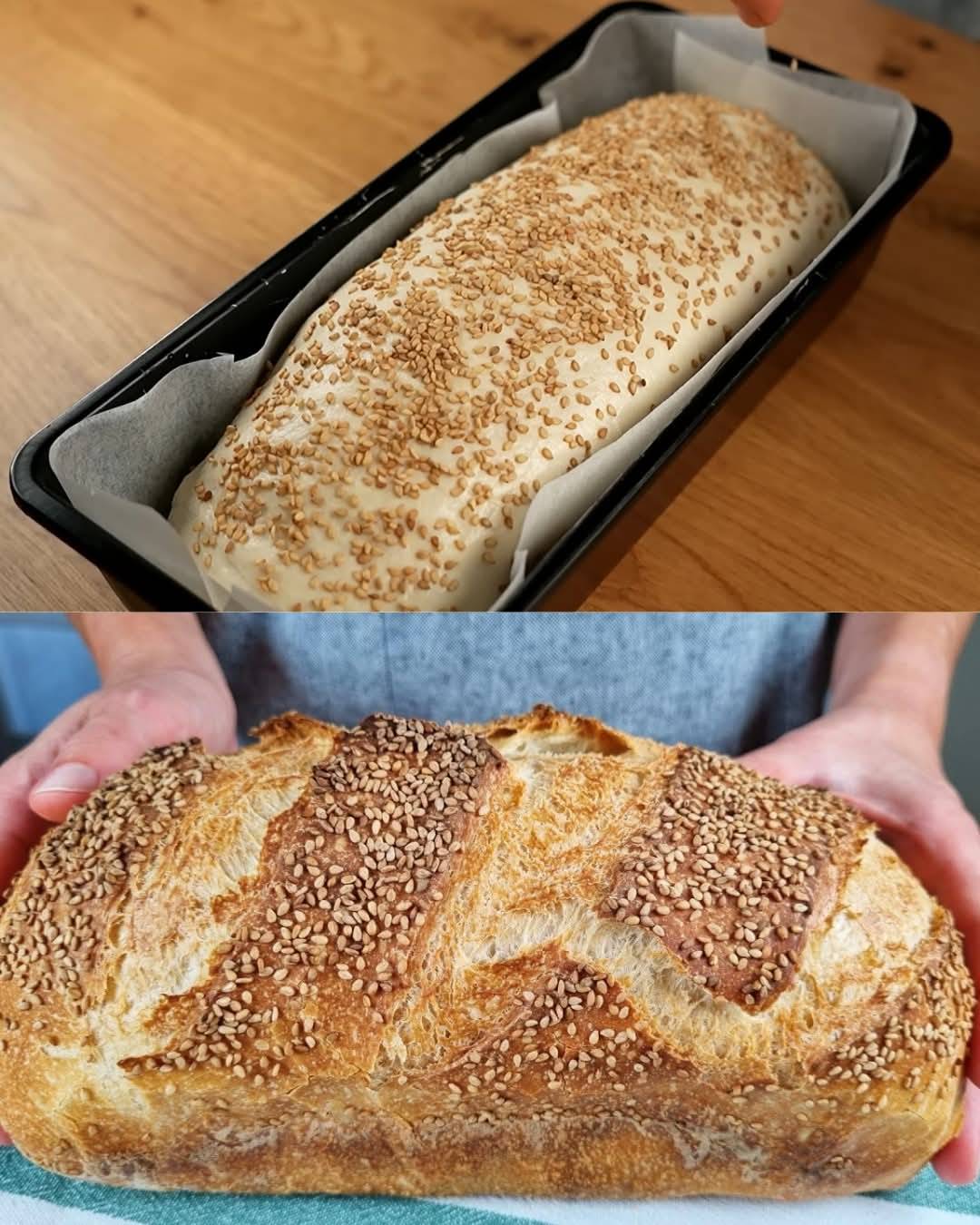There’s something incredibly satisfying about baking your own bread. The aroma of freshly baked bread filling the house is a comforting experience. This Soft and Fluffy Homemade Bread recipe is perfect for anyone looking to create a loaf that’s tender, airy, and delicious. Made with basic ingredients like water, yogurt, yeast, and flour, this bread requires minimal effort yet yields a soft, flavorful loaf with a slightly crispy crust. Whether you’re enjoying it for breakfast, lunch, or dinner, it’s versatile enough to complement a wide range of dishes or stand alone with just a spread of butter.
The best part is, you don’t need a bread machine to make this bread – just a bit of patience and some simple steps. This easy-to-follow recipe will give you a beautiful loaf with a slightly chewy texture that’s perfect for toasting, making sandwiches, or just enjoying with a meal. Plus, the addition of yogurt gives the bread a slight tang and contributes to its fluffiness.
Preparation Time
- Prep Time: 20 minutes
- Resting Time: 3 hours (including rising)
- Baking Time: 35 minutes
- Total Time: 3 hours 55 minutes
- Servings: 1 loaf (about 8 slices)
Ingredients
For the Bread:
- ⅔ cup (160 ml) water
- ¼ cup (60 g) plain yogurt
- 1 tsp fresh yeast (3 g) or ½ tsp dry yeast (2 g)
- A pinch of sugar (to activate the yeast)
- 1 tbsp vegetable oil
- 2 ½ cups (320 g) bread flour
- 1 tsp (6 g) salt
- Sesame seeds (optional, for topping)
Directions
-
Activate the Yeast:
- In a bowl, mix the water, yogurt, and yeast. Add a pinch of sugar to help activate the yeast. Stir well and let it sit for about 5 minutes until it becomes frothy.
-
Mix the Dough:
- Add the vegetable oil, bread flour, and salt to the wet mixture. Stir until the flour is fully incorporated. The dough should be slightly sticky but not too wet.
-
First Rest:
- Cover the bowl with a cloth or plastic wrap and let the dough rest for 30 minutes.
-
Stretch and Fold:
- After the initial rest, wet your hands and gently stretch all four sides of the dough towards the center. Fold each side to meet at the center and press down lightly.
- Use the “lift and slap” method to lift the dough and slap it back into the bowl. Cover and let it rest for another 30 minutes.
-
Second Stretch and Fold:
- Repeat the stretch and fold process once more. After this, let the dough rest for about 2 hours or until it doubles in size.
-
Shape the Dough:
- After the dough has risen, sprinkle some flour on your work surface. Gently fold the dough in half, then flatten it into a rectangle shape.
- Roll the dough tightly, then press down with your fingers to seal the edge. Pinch the seams to make sure it’s sealed well.
-
Prepare for Baking:
- Transfer the dough to a loaf pan lined with baking paper. Cover it with a towel and let it rise for another 30 minutes.
-
Preheat the Oven:
- Preheat your oven to 430°F (220°C).
-
Bake the Bread:
- Once the dough has risen, brush the top with a little water and sprinkle sesame seeds or other seeds of your choice on top.
- Use a sharp knife to score the top of the bread, making a few slashes across it.
- Cover the loaf pan with another loaf pan and bake for 25 minutes. Then, remove the top loaf pan and continue baking for another 10 minutes to crisp up the crust.
-
Cool and Slice:
- Once the bread is done baking, remove it from the oven and let it cool on a rack, covered with a towel, before slicing.
Nutritional Facts (Per Serving – Approximate)
- Calories: 150
- Carbohydrates: 30g
- Protein: 5g
- Fat: 2g
- Fiber: 1g
- Sugar: 1g
- Sodium: 200mg
The Origins and Popularity of Homemade Bread
Bread has been a staple food for millennia, dating back to ancient civilizations in Egypt, Mesopotamia, and beyond. It was one of the earliest foods to be made from cultivated crops, with the first breads likely being flatbreads made from flour and water. Over time, bread evolved into many different forms, influenced by geography, culture, and available ingredients.
In Europe, bread became a symbol of wealth and sustenance, and different countries developed their own bread-making traditions, from sourdough in Italy to baguettes in France. However, the process of making bread was a labor-intensive activity that required access to ingredients like yeast and a method of cooking the bread, such as a stone oven.
The popularity of homemade bread surged again during the 20th century with the introduction of modern conveniences like the bread machine, and more recently, with the resurgence of artisan baking techniques. Today, making homemade bread is seen as a comforting, rewarding activity that allows bakers to experiment with flavors and textures. This recipe, while simple and easy to make, brings back the traditional methods of bread-making while offering modern convenience.
Why You’ll Love This Recipe
- Simple Ingredients: This recipe uses basic pantry staples, making it easy for anyone to make, even if you’re not an experienced baker.
- No Kneading Required: This bread doesn’t require kneading, making it quick and less hands-on than many other bread recipes.
- Soft and Fluffy Texture: The addition of yogurt helps keep the bread light and airy, perfect for making sandwiches, toasts, or eating on its own.
- Versatile: You can customize the bread by adding different toppings, such as seeds or herbs, to give it your personal touch.
- Homemade Satisfaction: The process of making your own bread is incredibly rewarding, and the end result is a loaf that is far superior to store-bought bread.
Health Benefits of Homemade Bread
Homemade bread made from simple ingredients like flour, water, and yeast offers several health benefits:
- Whole grains provide fiber that supports digestion and helps regulate blood sugar levels.
- Yogurt adds probiotics, promoting gut health and aiding in digestion.
- No preservatives: Unlike store-bought bread, this bread doesn’t contain added preservatives or chemicals.
- Customizable: You can control the ingredients, allowing you to make a loaf that’s healthier, such as using whole wheat flour or adding seeds for additional nutrients.
Serving Suggestions
- With Butter and Jam: Freshly baked bread is perfect with a spread of butter and your favorite fruit jam for breakfast.
- As Sandwich Bread: Use it as the base for your sandwiches – it works wonderfully for everything from classic deli sandwiches to veggie-loaded subs.
- With Soup or Stew: A warm loaf of bread pairs wonderfully with a bowl of soup or stew, perfect for dipping.
- For Toast: Toast slices of the bread for breakfast and top with avocado, eggs, or any toppings of your choice.
- As a Snack: Enjoy it plain or with a drizzle of olive oil and balsamic vinegar for a light snack.
Tips
- Resting Time Is Key: Allowing the dough to rest and rise multiple times ensures a soft, fluffy texture.
- Use a sharp knife for scoring the top of the bread to prevent it from cracking awkwardly while baking.
- Experiment with Flavors: Feel free to add herbs, cheese, or garlic to the dough to create your own flavored bread.
- Keep the dough moist during resting periods by covering it with a damp towel or plastic wrap.
- Use a thermometer to check the doneness of your bread. It should reach an internal temperature of 200°F (93°C) when fully cooked.
Variations to Try
- Whole Wheat Bread: Substitute half or all of the bread flour with whole wheat flour for a heartier, healthier loaf.
- Herb-Infused Bread: Add chopped rosemary, thyme, or garlic to the dough for a fragrant twist.
- Cheese-Stuffed Bread: Add shredded cheese like cheddar or mozzarella to the dough for a cheesy surprise.
- Seeded Bread: Add sunflower seeds, pumpkin seeds, or flaxseeds to the dough or sprinkle them on top for extra texture.
- Garlic Bread: Mix garlic butter into the dough and sprinkle with herbs for a savory version.
Conclusion
This Soft and Fluffy Homemade Bread recipe is a simple yet rewarding way to bring the joy of fresh-baked bread into your kitchen. With minimal ingredients, no kneading required, and a soft, airy texture, this bread is perfect for any occasion. Whether you’re making it for sandwiches, to serve with soup, or simply to enjoy with a spread of butter, this loaf will undoubtedly become a favorite in your home. Homemade bread is a timeless treat that brings comfort and satisfaction with every bite.
5 Frequently Asked Questions
1. Can I use all-purpose flour instead of bread flour?
Yes, you can substitute all-purpose flour, but bread flour will give you a more chewy and slightly firmer texture.
2. How do I store homemade bread?
Store the bread in a plastic bag or airtight container at room temperature for up to 3 days. For longer storage, freeze it for up to 1 month.
3. Can I make this bread without yogurt?
Yes, you can substitute yogurt with milk or water, though the texture might not be as soft and tangy.
4. How can I make this bread vegan?
Use a plant-based yogurt and substitute the vegetable oil for olive oil or any other plant-based oil.
5. Can I freeze this bread?
Yes, slice the bread and freeze it in a bag for up to 1 month. Reheat it in the oven for best results.
Let me know if you’d like more suggestions or variations to try! 😊

